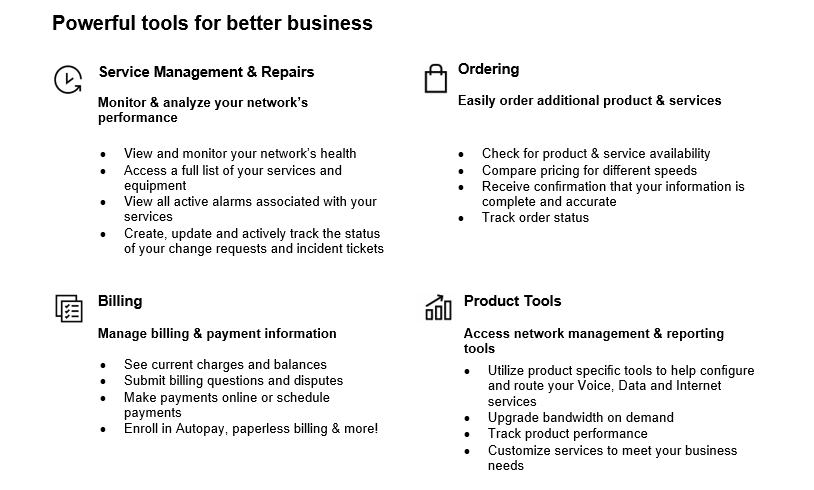-
Overview
-
The Virtual Network Services solution offers agility and flexibility to customers that need:
- Multiple combinations of network functions and/or multiple vendor services at their locations
- Low initial outlay costs
- Short service provisioning timeframes
- Rapid service scaling without re-investment in physical devices
Verizon’s Networking Services supports institutional and business demands for increasingly sophisticated and flexible networking products and services. Newer applications demand dynamic and agile network resources that can be incorporated, allocated and released quickly while maintaining high network reliability. To meet these requirements, Verizon has incorporated innovative new technologies such as Software Defined Networking (SDN), SDWAN (Software Defined WAN) and VNF (Virtualized Network Functions) into a suite of new products and services that:
- Help reduce time to market by enabling on-demand network function deployment and service activation.
- Control costs by replacing expensive, purpose-built networking hardware appliances with flexible and cost-effective hardware that integrates multiple virtualized network services either in a Verizon maintained cloud environment (Hosted Network Services), or an x86 based uCPE (universal Customer Premises Equipment)
- Create a more intelligent network that drives improved routing, easier management and greater flexibility.
- Allow fast changes to network services, with near real-time centralized management on the Verizon Enterprise Center Network Management Portal.
- React automatically to demand fluctuations with programmatic, rules-based network management.
- Uses Verizon built orchestration tools to automate the ordering, provisioning and operational management of the Virtual Network Services, giving customers the ability to make changes and additions to their service levels, sizes and features simply and easily.
Product license(s) applied on the new virtual instance is owned and managed by Verizon (This applies to Fully Managed, Co Managed and Monitor/Notify customers).
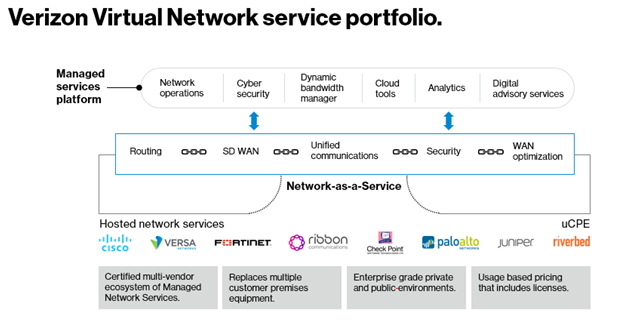
-
The Managed Service Implementation Manager is your primary contact regarding your Virtual Network Services deployment. The Managed Service Implementation Manager is responsible for the overall implementation and serves as your single point of contact throughout the course of the project. Your Managed Service Implementation Manager will arrange a Customer Kickoff Call/Order Verification Call to review and approve the Engineering Design Document and begin the implementation process.
Below is a list of activities to be performed by the Managed Service Implementation Manager:
- Schedule and run the Customer Kickoff Call/Order Verification Call.
- Perform overall project management services for the timely delivery and successful activation of the network with Verizon.
- Act as the ultimate point of escalation for the project team.
- Drive on-time delivery of the project and will pursue/escalate any unmet milestone deadlines.
- Host conference calls among all relevant parties.
- Develop the project plan jointly with you, the Verizon Account Team, and other support groups.
- Secure and matrix-manage all the resources necessary for project execution.
- Coordinate resource scheduling with Design and Implementation Engineers.
- Lead the development of processes and procedures required for network implementation.
- Oversee the completion of all steps in the defined process.
- Publish open action items and status reports.
- Establish reporting procedures with you and Verizon.
- Maintain the order tracking with milestone details for circuit/CPE Orders.
- Interface with Verizon organizations to collect status information.
- Act as the point of contact for any order-related issues.
- Confirm overall project delivery is compliant with the contract
- Conduct project closeout meeting. Transitions any remaining non-project issues for follow up.
- Provide re-engagement and, if applicable, change management instructions to you and the Verizon Account Team.
Note: E-mail communication sent by your assigned Managed Service Implementation Manager (MSIM) will contain their contact information along with escalation contact information in the signature section of the email.
-
Your Order Manager will communicate as needed in the form of periodic emails and/or follow up calls to provide status on key information regarding the implementation and activation of your Virtual Network Services. The Order Manager will work all aspects of the order directly with you and will gather any additional information needed. The Order Manager and Managed Service Implementation Manager will be in full communication with each other as your order progresses through completion.
-
Your Design Engineer is responsible for the physical and logical design and development of your network.
Below is a list of activities to be performed by the Design Engineer:
- Create your organization’s custom Engineering Design Document.
- Work with you to help develop an application Test Procedural Document (if applicable).
- Review & verifies your hardware and software configurations.
- Review redundancy, availability requirements, and security requirements.
- Make revisions to Engineering Design Document, as required.
- Review IP addressing scheme & request IP Addressing allocation for secondary addressing for network management.
- If required, implement the necessary controllers, either on premises or in the Verizon data center.
- Responsible for Proof-of-Concept Implementation (typically the hub and a few remotes), including testing of VNF functionality.
- Verify visibility to your network for network management (i.e., management PVCs) once the link has been provisioned.
- After a successful Proof of Concept implementation, will provide the activation/technical requirements template and transition the project to the Implementation Engineer.
-
The role of your Implementation Engineer is to act as the technical point of contact during any required device installations while providing virtual support on all managed equipment or circuits, taking over the network implementation from the Design Engineer after the first few sites are implemented.
Below is a list of activities to be performed by the Implementation Engineer:
- Communicate with you as necessary for required technical information.
- Confirm out-of-band modem and Layer 1, 2, and 3 connectivity for the hardware and access.
- Validate all necessary WAN circuits are passing IP traffic as designed.
- Build logical configurations for connectivity to your network.
- Act as your technical point of contact during device activation.
- Test devices to verify they meet standards for security and compatibility with your existing network devices.
- Testing of VNS policies as necessary.
-
If the project has a security feature (VNF), your Network Security Engineer (NSE) is responsible for the logical design and implementation of your Security VNF.
Below is a list of activities to be performed by the Network Security Engineer:
- Review redundancy, availability requirements, and security requirements.
- Make revisions to Engineering Design Document, as required.
- Provide activation/technical requirements template for applicable Security Services.
- If required, implement the necessary element managers, either on premises or in the Verizon data center.
- Work with you to apply your Initial Security policy configuration.
- Provide support for external server integration when required for Next Generation services.
- Confirm visibility to your Security with Virtual Network Functions (VNFs) for network management.
- Communicate with you as necessary for required technical information.
- Act as your technical point of contact during device activation.
- Test devices to verify they meet standards for security and compatibility with your existing network devices.
- Assist in testing of initial Security policies as necessary.
-
Upon successfully completing the requirements of your Virtual Network Services, your network services will be handed off to the Verizon Network Operations Center). The Verizon Network Operations Center will be responsible for incident and change management activities after your solution is accepted under management.
Within the Verizon Network Operations Center, your organization will have a Project Engineer assigned. Below is a list of activities to be performed by the Project Engineer:
- Verify that the order meets the criteria for the Verizon Network Operations Center to manage the service.
- Act as Point-of-Contact for non-real-time-service issues.
- Act as Point-of-Contact for your Terminal Access Controller Access Control System (TACACS) account requests and password resets.
- Act as Point-of-Contact for your WAN Analysis account registration and password resets.
- Set up your Netflow Customer Product Administrator (NCPA) on the WAN Analysis Portal.
- Maintain the Enterprise Service Portal (ESP), the Managed Network Service (MNS) Database of Record
- Act as Point-of-Contact for Customer contact notification and device inventory audit reports via ESP.
For more details, click on the Network Operations Center in the left navigation of this welcome kit.
-

-
Your Managed Service Implementation Manager will review the site requirements with you on the Customer Kickoff Call/Order Verification Call.
Customer action
If you will have any new services either activated or installed, please review the following site readiness details below, and take appropriate action as needed.
Site requirements
Review the Verizon’s Customer Readiness Website. This site will assist you in preparing for your Virtual Network Services with Verizon. Reviewing the content on this site and following the simple steps listed will help facilitate a smooth installation and activation of your service.
-
Physical requirements [universal Customer Premise Equipment (uCPE) only]
When there are physical, onsite components to your Virtual Network Services, you must take specific action and/or ensure that the following items are appropriately addressed:
- The local contact must verify receipt of “room ready” requirements such as secure space for service equipment, power levels for the circuit and equipment as communicated by Verizon and conduit /cabling path and wiring needed to connect equipment to the Demarcation (DEMARC) requirements and a date on which they will be completed.
Customer action
You are responsible for general inside wiring which is not part of the activation of the customer premises equipment (uCPE) or services.
- If applicable, assume responsibility for hardware, software and memory compatibility issues related to existing equipment you choose to use.
Demarcation (DEMARC) extensions
If any of the Virtual Network Services Verizon will handle for you need to be extended beyond the telecommunications demarcation point, you are responsible for ensuring that extended demarcation facilities are installed and ready before implementation.
You may be able to order a DEMARC extension from Verizon or a third-party local exchange company (LEC).
Note: Delays in extending your DEMARC may result in VNS implementation delays.
Power requirements (uCPE only)
Loss of electrical power may cause your Verizon access service to cease working if there are no accommodations made for back-up power. Verizon highly recommends that you install an Uninterruptible Power Supply (UPS) onsite.
Verizon does not provide UPS units; however, if you choose to implement a UPS, the following are some guidelines to maintain communications in case of a power outage:
- Back-up the entire building using UPS. This will protect all devices and equipment from power failures, including telephony, data networking, and PCs.
- Provide a separate generator for back-up power (in addition to the feed provided by the utility company). In this case, you may still need to add UPS, because it may take a few minutes for the generator to ramp up.
Note: The advantage of this approach is that less battery time is needed for each UPS. You should consult with your Managed Service Implementation Manager for any additional power requirements, as needed.
Issues
The graphic below shows some common situations that may cause issues or delay your Virtual Network Services.
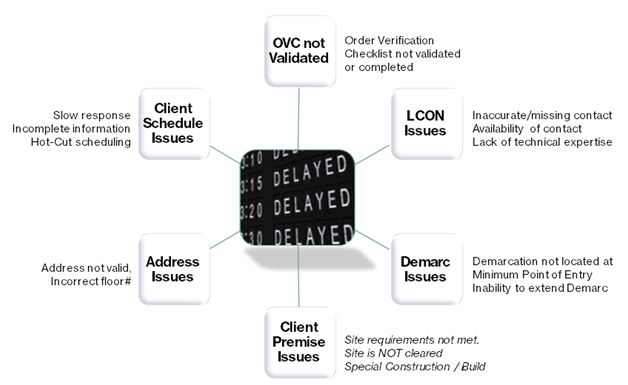
For more detailed information about preparing your site for your upcoming installation (either performed by you or Verizon), please refer to Verizon’s Customer Readiness website.
-
To successfully deliver your Managed SD WAN Services, there are some activities that must be completed by both Verizon and you. Our goal is to keep you informed and aware of all the steps.
Verizon steps
Verizon will take the following actions to provide a smooth implementation of your Managed SD WAN Services:
- Your Managed Service Implementation Manager will provide you with their contact details, and other information associated with your Managed SD WAN Services order.
Note: You will also receive the full contact details for your Order Manager, Design Engineer, Implementation Engineer, and any other relevant Verizon contacts.
- Your Managed Service Implementation Manager will schedule a Customer Kickoff Call/Order Verification Call with you and other Verizon team members.
- Upon successful submission of your Managed SD WAN Services order, your Managed Service Implementation Manager would be your lead contact for the project to provide weekly status calls and as needed communications.
- Verizon Account Manager will send you the SD WAN Inventory Template. The template will be used by your Verizon service delivery engineers to properly configure the managed router with the correct Managed SD WAN policies.
Note: Ask your Verizon Account Team for details on how to properly fill this out.
- Your Managed Service Implementation Manager will arrange the Customer Kickoff Call/Order Verification Call with you, your Order Manager, Design Engineer or Solution Architect , and the Implementation Engineer to help develop your Engineering Design Document (i.e., IP Address plan, SD WAN policy development, etc.).
- If support is required to inventory applications and develop the correct SD WAN policies, Verizon offers support via our Professional Services organization. Contact your Verizon Account Team for more information.
- After the kickoff call, the Design Engineer documents the details, the service needs, and sends the Engineering Design Document to you for approval. When approved, then Design Engineer starts to work on design, documentation and configurations.
- Confirmation of your schedule implementation timeline with your Managed Service Implementation Manager and the Design Engineer.
- Your Managed Service Implementation Manager will coordinate all project components from start to finish as part of the service:
- Examples:
- Verizon will project manage (through your Managed Service Implementation Manager) the staging, configuring and installation of your routers purchased from Verizon at your facility.
- Provisioning and installation of circuits at your facility.
- Coordinate 3rd parties as necessary
- Submit Letter of Authorization (LOA) for finalization of your managed services. Also, may be referred to as Letter of Agency (not Applicable if Monitor and Notify Class of service is selected).
Note: Ask your Verizon Account Team for details on how to properly fill this out.
- Provide periodic updates on the progress surrounding the Managed SD WAN Services implementation.
- Notify you in advance of any system maintenance and/or Telco work that could impact your installation schedule.
- Advise via “handoff” email from your Managed Service Implementation Manager once the network is under “managed” status and billable.
- After your site is under management, the Verizon Network Operations Center assumes the responsibility of your network services.
Customer steps
The following steps on your part will also lead to a successful and timely delivery of your Managed WAN Services:
- Attend the Customer Kickoff Call/Order Verification Call. Your Managed WAN Services order is unable to move forward without your attendance on this call.
- Verify your site-specific information and circuit information prior to Verizon submitting the order. This confirms orders comply with your site requirements. The correct site address information should be supplied.
- Provide information as requested by your Managed Service Implementation Manager, Design Engineer, and/or Implementation Engineer.
- Begin to assemble details for the areas to be requested within your SD WAN Inventory Template and Engineering Design Document.
Note: To speed up the process, you should have ready all of the information needed for your SD WAN Inventory Template and Engineering Design Document before this call. The primary items needed for the Engineering Design Document are found later on within this welcome kit.
- Begin to identify network applications, inventory applications that will be included in SD WAN policies, and complete the Managed SD WAN Application Inventory Template. Your Verizon Account Team will provide the matrix and instructions for completion.
Note: To speed up the process, you should have ready all of the information needed for the Managed SD WAN Application Inventory and Policy Creation matrix before the Engineering Design Documents are approved.
- Submit your SD WAN Inventory Template to Verizon.
Note: Ask your Verizon Account Team for details on how to properly fill this out.
- Review and approve your organization’s Engineering Design Document
- Provide all information necessary to implement the service and be able to work with the Verizon installation engineer for information like the IP Address plan. Verizon needs to understand the IP addresses associated with your Managed SD WAN Services plan. For Private IP, Verizon would provide the IP addresses to avoid any address overlapping or confusion.
- If needed, prepare your site for installation (as outlined below).
As an example, upon notification by Verizon of the Telco tentative dispatch date, you should ensure each local contact will be onsite for the installation and knows about the pending order. If the local contact will be unavailable, an alternate contact must be provided to avoid a reschedule and missed appointment.
Instruct the local contact(s) to direct the Local Exchange Carrier (LEC) technician to the location where the circuit demarcation (Telco Closet) is to be placed and advise them if the demarcation must be extended other points within the building.
- Notify Verizon as far in advance as possible of any times during which activations or installations may not be scheduled so as to not impact your delivery schedule.
- If a change to the established activation/installation date is required, communicate those changes as soon as possible to your Managed Service Implementation Manager.
- Inform Verizon of any networking changes (your facility, 3rd party changes, etc.) that are relevant to your Managed SD WAN Services.
- The Verizon Managed SD WAN solution on Public Cloud (AWS, Azure) provides for hosting of the SD WAN Cloud instances in a customer tenant space called the VPC (Virtual Private Cloud on AWS) and vNET (Virtual Network on Azure). As part of the deployment process, the customer has to provide Verizon with information about the AWS or Azure Account/Subscription ID and also provide access to this tenant space through the deployment of templates handed over by the Verizon design engineer (DE) during the deployment process.
Note: As part of a VNS Application Edge deployment all orders will include professional service engagement as part of the solution. You will work with your assigned engineering resource as the deployment progresses.
Customer Kickoff Call/Order Verification Call
The Customer Kickoff Call/Order Verification Call is the first gathering set up by your Managed Service Implementation Manager after your Managed SD WAN Services contract has been signed. The call would consist of:
- Verizon Managed SD WAN Services team introductions, roles, and responsibilities
- Expectations of Verizon and your organization
- Validate the project scope and services
- Discuss timelines and deliverables
- Next steps
Note: The Customer Kickoff Call/Order Verification Call is for the complete Managed WAN Services order and not for each individual location covered under the order. Your Managed WAN Services order is unable to move forward without your attendance on this call.
Your Managed Service Implementation Manager will provide you with the due dates for the activation/installation of the services handled by Verizon through your Managed SD WAN Services. These are the dates Verizon will be ready to activate/install your service(s).
Note: It is your responsibility to have a local contact to be present on the due dates provided to avoid re-scheduling and potential service downtime.
Note: Your Managed Service Implementation Manager will be your primary point of contact moving forward until the completion of your Managed WAN Services.
-

-
Verizon-performed installations
As a part of your Virtual Network Services with Verizon, installations may be required for the services you need. If you choose to use Verizon for your installation needs, note the following steps will occur.
- Your Managed Service Implementation Manager will coordinate Verizon installation dates with you and/or your local contact for your Virtual Network Services.
- If needed, a pre-installation survey may occur before the actual installation (depending on the product).
- Verizon will dispatch the installation team(s) for the service to your location(s).
- As needed, Customer may have defined responsibilities.
-
Customer action
The local contact must ensure that technicians have access to all on-premises wiring and space locations.
Note: After hours fees may apply. Please review your contract for details on these charges.
- Post-installation, Verizon will verify the network service is provisioned and will send information that service is complete.
Note: Only installation services purchased through Verizon would be coordinated by your Managed Service Implementation Manager. Any delays with outside vendor services associated with your Virtual Network Services may impact the timing of the management of your services.
Customer action
After implementing your Virtual Network Services, any new services may have to go through the contracting process. Ask your Verizon Account Team for more details.
3rd party/self-installations (uCPE Only)
If you choose to have your installations performed by a 3rd party or through your internal means, it is your responsibility to provide any updates or details to the Managed Service Implementation Manager.
Note: Only installation services purchased through Verizon would be coordinated by your Managed Service Implementation Manager.
-
Service disruptions can hurt a company's bottom line and compromise an organization's mission. The economic and reputational imperatives of the current market have shifted the discussion from IT disaster recovery to an enterprise-wide business continuity focus.
Organizations of all sizes and industry types should have ongoing, enterprise-wide Business Continuity Programs that develop, prepare and exercise the various areas of continuity from critical business processes to IT service availability. The Business Continuity Program should address areas such as Emergency Response, Impact Analysis, Business Continuity Plans, Disaster Recovery Plans, Supplier Plans, Exercises, and ongoing Business Continuity program management.
The goals of today’s most relevant Business Continuity Programs are those providing organizations with an enterprise-wide business continuity focus, that not only includes strategizing and planning for IT service availability and disaster recovery but addresses the ability to manage all areas of critical and continuity activities of the program to help prepare and mitigate the impact from ever-increasing risks threatening to interrupt organizations’ critical processes.
Verizon helps our customers to effectively prepare and maintain continuity during planned and unplanned events to help reduce the risk and impact from disruptions. Please contact your Verizon account team for further assistance.
-
Easily Manage your Services Online
The Verizon Enterprise Center makes it easy for you to monitor, manage, analyze and optimize your Verizon products and services online. Available seamlessly between desktop, tablet and smartphone – you can act on your crucial data wherever your work takes you.
-
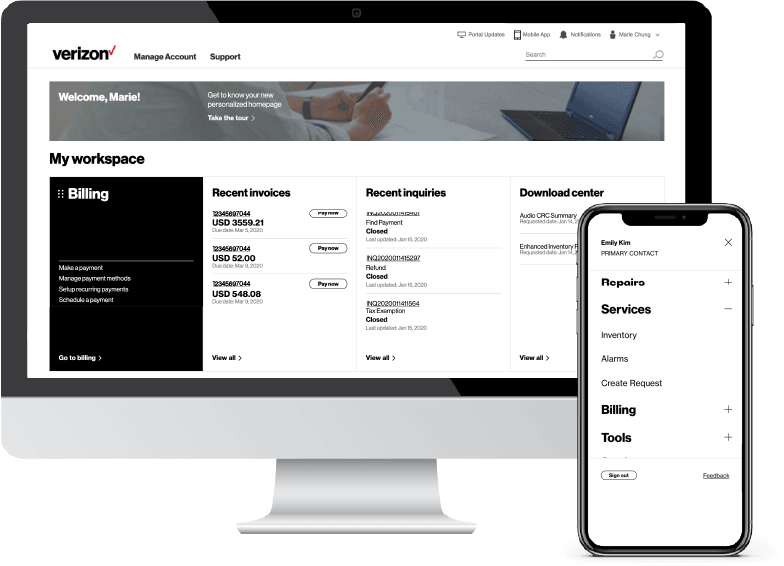
-
Register for the Verizon Enterprise Center
- Go to sso.verizonenterprise.com/ or download the My Verizon for Enterprise mobile app
- Click the ‘Register’ link
- Enter the invitation code you received to complete registration.
-
Global Change Management
Global Change Management (GCM) is a framework within Verizon Enterprise Center portal of multiple integrated applications for ITIL-based service management. It is designed to simplify the change management process for Verizon customers through the Verizon Enterprise Center portal. In the Global Change Management framework, you can create and submit Managed Network Services change or service requests through Verizon Enterprise Center portal.
When changes become necessary, Verizon engineers work closely with you to review, assess, schedule, and execute required changes. Changes to networks are categorized into standard and optional, depending on the impact to the network. Optional requests—generally defined as requirements that alter the existing network design—are routed to engineering through a project initiated by the account team.
For SD WAN service on public cloud (AWS), the customer is required to communicate any changes in credentials by opening up a new CR (Change Request) with the type “Update Public Cloud Credentials”. The customer is required to keep the older credentials intact on AWS until the time the new credentials are updated in the Verizon systems using the CR fulfillment process. AWS does allow the customer to operate with 2 sets of Access and Secret key credentials for the same IAM (Identity Access Management) user setup in AWS. Once the new credentials are updated and confirmed by the Verizon team fulfilling the CR, the customer can delete or remove the older credentials.
Note: Information on the Global Change Management activities associated with the Full Management and Co Management service levels may be found within the Verizon Enterprise Center portal.
-
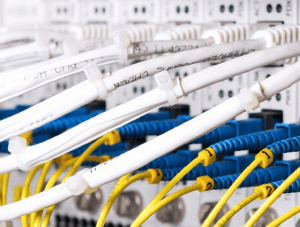
-
Virtual Network Services are available with the following Management service levels: Full Management, Managed Security Services (MSS) Management, Co Management or Monitor
- Full Management means that Verizon fully manages all parts of the service including any underlying hardware. For certain SD WAN solutions, customers also have the option to self-manage firewall/Unified Threat Management (UTM) policies using Verizon Enterprise Center.
- Managed Security Services (MSS) Management is available for Virtual Network Services – Security only. In this case the MSS Security Operations Center (SOC) will manage the security service VNF component.
- Co Management means that Verizon implements all parts of the service including any underlying hardware and post implementation, and provides Portal and API access so customers can manage their own SD WAN policies (only available for some SD WAN solutions) and customers also have the option to self-manage firewall/UTM policies using Verizon Enterprise Center. Policies that are not accessible to the customer are managed by Verizon.
- “Monitor”, Verizon is responsible for the initial implementation. After operationalizing the network, Verizon will provide notification of VNF service outages only. Customer will be responsible for all policies, patching and updating of the VNF software.
Note: Your level of service is based on your contractual agreement with Verizon.
-

-
WAN Analysis (Available for SD WAN)
Verizon WAN Analysis service enables our customer’s visibility on end-to-end performance as well as trend analysis reports for their data networks. Through a role based graphical dashboard, the information can be designed to the requirements and interests of the different users: executive summary as well as the Permanent Virtual Circuit (PVC) detailed utilization data for the network administrator. Easy accessibility through the standard Web Browser.
Your Verizon account team will coordinate the enablement as well as the training sessions with the Performance Reporting Help Desk.
WAN Analysis tools may also be found within Verizon Enterprise Center. The WAN Analysis Reporting Welcome Kit includes all of the information you need to know about the service.
-

-
Virtual Network Services are network tasks that operate within a virtual software-based environment rather than the traditional appliance-based network functions, where a single piece of proprietary, purpose-built hardware is associated with each distinct network task. This decouples network tasks from dedicated hardware devices, allowing for faster deployments with less hardware, and much greater flexibility. The services in the Virtual Network Services offering can be either service chained together so that the network traffic passes through the applications in a certain specified order – e.g., traffic will pass through the firewall before WAN Optimization, or it can be separated so that some traffic will be directed to one set of network services, while other traffic will traverse another set. An example might be a data replication application between a local and remote storage device would only need the traffic to be directed to the WAN Optimization application. The options are available on the following platforms:
-
- Verizon Hosted Network Services
- Premises based Universal CPE (uCPE)
- Premises based Dedicated (or purpose-built) – SD WAN only
- Public Cloud hosted (AWS, Microsoft Azure)
Below is a brief description of each of the Virtual Network Services portfolio of services available currently. Additional details and breakdown of the individual vendor service packages can be provided by your Account Manager.
-
Virtual Network Services Routing expands customers’ options for what routing services are available with the premises-based Deployment Model. Not only are customers are able to select from different sizing models, but they are able to choose the router image that matches with the rest of their network architecture. Due to the nature of routing, all Virtual Network Services - Routing offerings are service package feature set “Core,” encompassing all the standard features provided by the router vendor.
Virtual Network Services Routing is delivered with integrated full service management and transport services by Verizon and Verizon 4G LTE. “Monitor Only” is not available with the Routing at this time. The following vendor is currently part of the Virtual Network Services – Routing portfolio:
- Cisco cSR1000V
-
Virtual Network Services – SD WAN takes Verizon’s Managed WAN service offering to the next level by moving from a proprietary hardware Deployment Model to virtual services that can be spun up and deployed using a pre-defined catalog of virtual functions. Customers are able to select from different network capacity models to accommodate their bandwidth requirements. Virtual Network Services - SD WAN offerings are available in feature sets “Essential,” “Core,” or “Complete,” depending on the features provided by the vendor.
Virtual Network Services SD WAN is delivered with integrated full-service management, Co Management or Monitor Services provided by Verizon. SD WAN services are available on premise either dedicated or on uCPE, on Verizon or third-party hosted platforms. The following vendors are part of the Virtual Network Services – SD WAN portfolio:
- Cisco vEdge (Viptela OS)
- Cisco cEdge (IOS XE SD WAN)
-
Virtual Network Services - Software Defined Secure Branch expands customers’ options for a new combination of SD WAN and Security services in one package delivered on premise either purpose-built, on uCPE, or on Verizon or third-party hosted platforms. the Hosted platform Customers are able to select from different network capacity models to accommodate their bandwidth requirements. Virtual Network Services - Software Defined Secure Branch offerings are available as service packages “Essential,” “Core,” or “Complete,” depending on the features provided by the vendor.
Virtual Network Services - Software Defined Secure Branch is delivered with integrated service management, provided by Verizon. Software Defined Secure Branch is available with Full Management, Co Management and Monitor service levels. Co-Management is not available for the Software Defined Secure Branch + WAN Optimization (Riverbed) solution bundle.
The following vendor is currently part of the Virtual Network Services – Software Defined Secure Branch portfolio:
- Fortinet
- Versa
-
Virtual Network Services - Security includes end-to-end, full-service management and can protect Private IP (MPLS-based VPN), Internet network circuits, or wireless provided by Verizon or other carriers.
All the security products offered have built-in Essential functionality. Both the Core and Complete options build on the Essential level offering. The services are available either on premises or on the Hosted platform. Customers are able to select from several different network capacity models, to accommodate their capacity requirements. Detailed information about the features included in each feature set can be provided by your Account Manager.
With Virtual Network Services-Security, Customers have the choice of Full Management or Monitor Only Service Levels. Details about the differences are found in Managed Network Services Support Options above. The following vendors are currently part of the Virtual Network Services – Security portfolio:
- Palo Alto
- Fortinet
- Check Point
-
Virtual Network Services (VNS) – SBCaaS expands customers’ options for securing their VoIP infrastructure via SBCs deployed and managed as a service. VNS - SBCaaS has two distinct and separate service bundle offerings, defined below. Both SBCaaS service bundles are available on the Hosted Network Services (HNS) platform with full management only. Customers are able to select from different sizing models to match their expected call capacity (simultaneous sessions) requirements. The “Session Border Controller” feature for VNS provides various levels of service, leveraging standard license options from the technology partners. Detailed information about the features included in each feature set can be found on Insite, Virtual Network Services Feature Matrices.
-
Virtual Network Services – SBCaaS (Session Border Control as a Service) solution utilizes an all Verizon Private IP interconnect. The VNS - SBCaaS connects to both the Enterprise Private Branch Exchange (PBX) and Verizon SIP Trunking via Verizon Private IP network.
Note: Intra-enterprise routing must traverse Verizon retail VoIP Session Border Control (SBC.).
-
Virtual Network Services - SBCaaS Integration with Third Party Unified Communications (TPUC) solutions provides SBCaaS to customers who utilize a third party unified communications platform instead of an on premise PBX. The solution uses public IP addresses over the Internet to interface with the TPUC and Verizon’s Private IP network and SIP Trunking networks.
Only approved TPUC platforms will be supported by this solution offering. It is the customer’s responsibility to obtain any and all signed digital certificates, as required for encrypted connections, from the TPUC. Verizon will not have a relationship with the TPUC; as such, Verizon will not resell or in any way commercially participate with the TPUC. Furthermore, Verizon will not assume any responsibility for managing or maintaining the TPUC. Enterprise customers are fully responsible for managing their relationship with the TPUC.
Note: Intra-enterprise routing must traverse Verizon retail VoIP Session Border Control (SBC.).
Approved third party unified communications platforms: Currently, there is only one TPUC platform approved by Verizon for use with this feature:
- Microsoft Teams
Virtual Network Services - SBCaaS is delivered with integrated “Full” management provided by Verizon. The following technology partner is currently part of the Virtual Network Services – SBCaaS portfolio:
- Ribbon Communications
-
Virtual Network Services - WAN Optimization (Current Platform) is delivered with integrated full-service management and supports a variety of transport services, such as Private IP and Internet Dedicated Services, provided by Verizon. It also is able to support Verizon 4G LTE. The services are available either on premises. Customers are able to select from different sizing models to match their expected capacity (connections) requirements.
Customers have the choice of Full Management or Monitor Only Service Levels. Details about these Service Levels and the differences between them are found in the Managed Network Services Options listed above. The following vendors are part of the Virtual Network Services – WAN Optimization portfolio:
- Riverbed
-
VNS Application Edge is an entirely different way of orchestrating, hosting, deploying, and managing customer containerized applications at the network edge and across heterogeneous clouds.
VNS Application Edge, available as a VNS service on the premise-based uCPE, provides a means for application lifecycle management and multi-cluster deployments of containerized applications.
This is possible by giving you the ability to securely and easily host, manage, and control your own applications at your remote locations through the Verizon VNS Application Edge portal while helping to optimize performance by deploying applications where you need them to be in your networks.
That means, latency sensitive or data intensive applications can be deployed on site helping to provide a better user experience and a more efficient use of bandwidth.
An added benefit of the solution is Verizon manages both your network and the application infrastructure at the edge. This premise based complete Kubernetes cluster is securely and logically separated from any other VNS network services on the same uCPE device.
You manage the Kubernetes platform—monitoring and upgrading the platform as required, while Verizon monitors and manages the underlying uCPE hardware and network infrastructure, just as Verizon would do with any other VNS service.
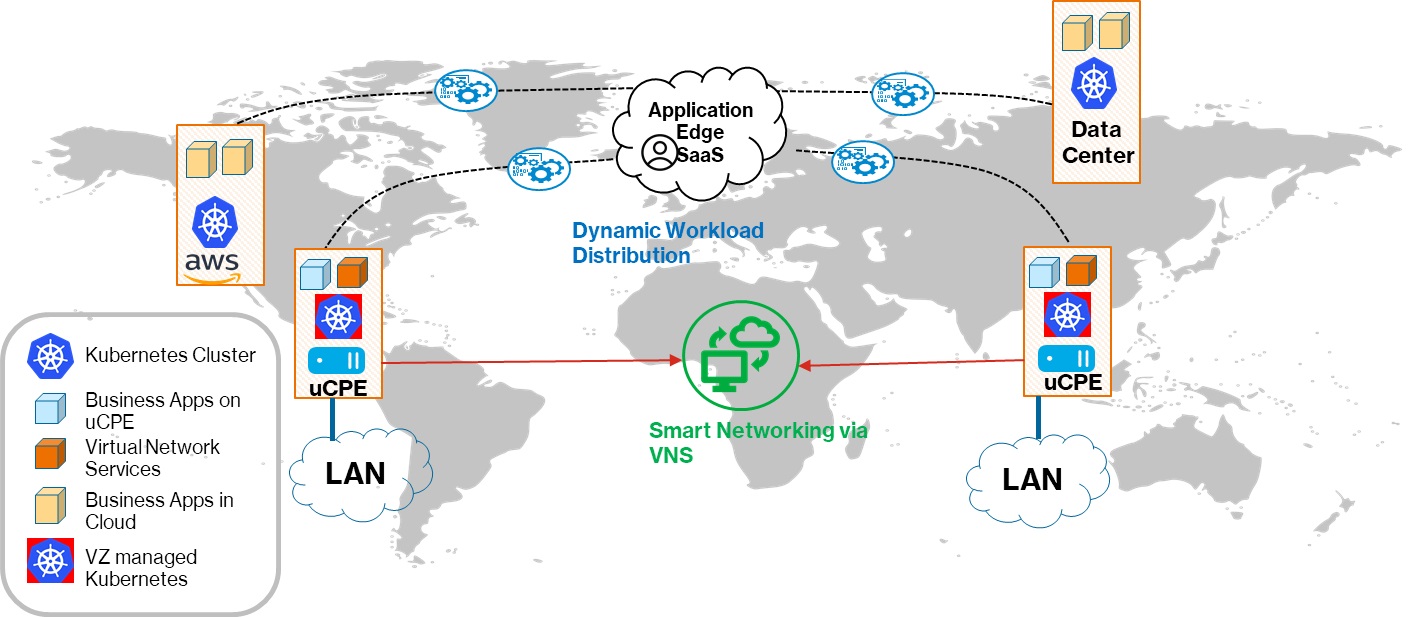
Figure 1: VNS Application Edge in a Nutshell
The power of VNS Application Edge comes from the VNS Application Edge management portal that enables you to deploy and manage all your Kubernetes clusters through the entire Software Development Lifecycle (SDLC).
This means that you can easily manage of your applications across your WAN networks, without having to worry about managing the network itself, while having the ability to centrally manage all of your Kubernetes clusters, wherever they are in your network, at their remote edge locations, or in multiple public or private clouds.
VNS Application Edge is network and VNS Solutions Bundle agnostic enabling you to deploy your applications on whatever LAN or WAN network environment you choose.
Note: You will need to have at least one of these VNS functions deployed: SD WAN, , or Routing in order to implement VNS Application Edge. You must also have or allow Internet connectivity to enable access to the portal.
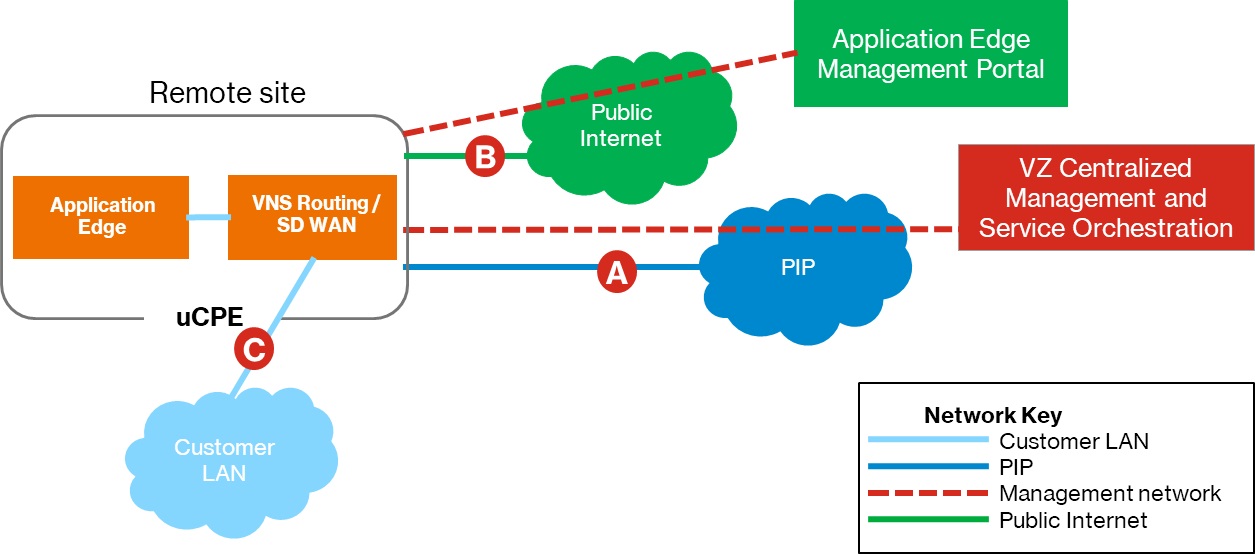
Figure 2: Application Edge Network Diagram
Key features of this service include:
- App Ready Kubernetes Cluster: The VNS Application Edge clusters are deployed by Verizon during the standard VNS service delivery process, ready to be used as soon as you are given access to the Portal.
Note: Therefore, there is no manual set-up required, helping to eliminate the tedious and time-consuming effort required to deploy clusters at any scale beyond a handful.
VNS Application Edge allows you to manage automated Kubernetes upgrades and software patches across multiple locations through the easy-to-use portal.
- Multi-cluster/Multi-cloud management via a Single Pane of Glass: You are able to manage hundreds or thousands of Kubernetes clusters from one central management portal, for tighter control of the environments wherever they are located on your network edge and/or in multiple public or private clouds.
- Note: You can make uniform changes and updates to applications and the cluster itself can be made across all or selected sites simultaneously regardless of location – at the edge or in the cloud.
- Single pane of glass: The VNS Application Edge Portal, which is accessed by a link on your Verizon Enterprise Center Dynamic Network Management (DNM) portal, allows you to manage not only all of your VNS Application Edge Kubernetes clusters located on your remote sites, but also your Kubernetes clusters from third parties located in public and private clouds.
Note: This enables you to deploy and upgrade your apps from a central place, helping to reduce management overhead and the potential for errors
Note: You also receive monitoring support and proactive notification through the Portal. - Software development Life Cycle: The Portal allows you to manage the full application lifecycle from one central portal.
- Comprehensive Kubernetes Management Platform: The VNS Application Edge portal includes tools to manage the Kubernetes platform itself, which helps to simplify updates and Software Development Life Cycle processes across all the Kubernetes clusters under management.
- Single pane of glass: The VNS Application Edge Portal, which is accessed by a link on your Verizon Enterprise Center Dynamic Network Management (DNM) portal, allows you to manage not only all of your VNS Application Edge Kubernetes clusters located on your remote sites, but also your Kubernetes clusters from third parties located in public and private clouds.
- Security: You have access to the VNS Application Edge Portal environment through the Verizon Enterprise Center Dynamic Network Manager (DNM) portal, which allows you to use the Verizon Enterprise Center Role Based Access Control (RBAC) features, plus additional more fine-grained access controls on the VNS Application Edge Portal. You can therefore control exactly who has access and what they can do with that access.
Note: Verizon does not have access to either your VNS Application Edge Portal or any applications that are deployed within the VNS Application Edge cluster itself.
- Optimized App performance: Bringing applications that demand low latency, near real-time processing, or both closer to the end-user, help enable new immersive experiences like virtual reality and 4K content delivery networks and can add opportunities for real-time data analysis and decision-making using artificial intelligence and machine learning.
- More efficient use of bandwidth: Depending on the application, there is the potential for more efficient use of the bandwidth at the remote site, since the applications might take advantage of the ability to pre-process the data and only transmit the important information in a more compact form into public or private cloud locations.
That also means that on-premises data sent to a data center or the cloud can be aggregated.
The service is available with a choice of 3 capacity sizes based on a standard amount of compute, storage and memory resources allocated.
These resources are pinned, that is reserved your use only to help assure that the cluster will perform as expected. These resources are logically and securely separated from the other components on the uCPE.
That means the applications have fixed resources available, as contracted for, and do not compete for resources from oversubscription or noisy neighbors from any other services deployed on the same hardware.
The 3 options with details of the resources available for each are listed below:
- Small: A ready built Kubernetes managed container environment that includes 8 cores, 16GB Random Access Memory (RAM) memory, and 400GB persistent storage.
- Medium: A ready built Kubernetes managed container environment that includes 16 cores, 64 RAM memory, and 2 Terabytes (TB) persistent storage.
- Large: A ready built Kubernetes managed container environment that includes 24 cores, 128GB RAM memory, and 3.5TB persistent storage.
Once VNS Application Edge has been deployed at the location by the Verizon Service Delivery team, you will have access to the VNS Application Edge portal from the Verizon Enterprise Center and will be able to deploy and manage your applications. As with any of the VNS services, Verizon manages the underlying environment, the virtual machine image itself and any other support of the service.
The service is sold with the Co Management service level. Application and cluster management is your sole responsibility. Verizon does not manage or deploy your applications or maintain or upgrade the Kubernetes cluster.
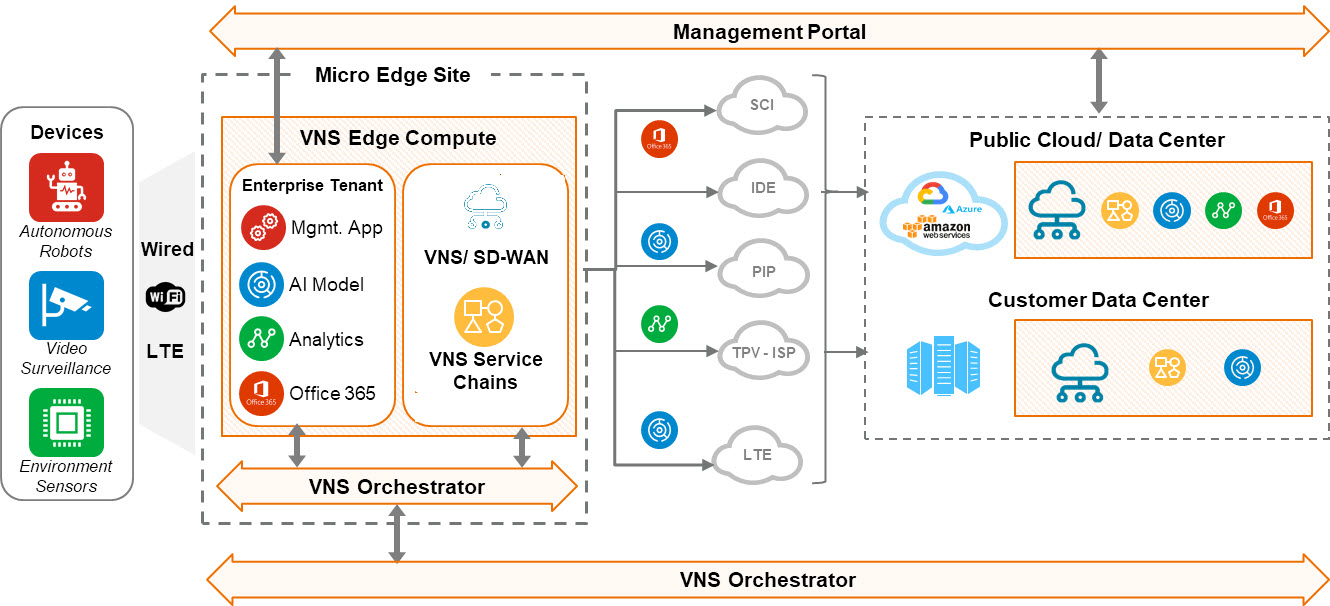
Figure 1-9: VNS Application Edge Architecture Overview
-

-
Upon successful completion of the requirements for your Virtual Network Services, your network services will be handed off to the Verizon Network Operations Center for proactive monitoring.
Your Managed Service Implementation Manager will send a “handoff” email to you and anyone else you designate within your organization. The email will:
- Confirm your network is officially under management
- Network Operation Center points of contact
- Explain the process to report in-scope and out-of-scope network changes
-
Customer action
If you do not receive a handoff email from your Managed Service Implementation Manager, please contact your Managed Service Implementation Manager directly to determine the timing of the transition of your network services to the Network Operations Center.
The Network Operations Center handles a broad range of transport and network types to support Managed Network Services:
- Virtualized Network Services
- SD WAN
- Managed WAN
- Private IP (MPLS)
- IPsec VPN
- Internet Dedicated Services
- Internet Broadband Services
- Third Party MPLS
- Third Party Internet
- Wireless (ordered through Verizon)
-
The Network Operations Center performs automatic alarm detection, fault isolation, trouble-ticket generation, event and maintenance correlation, customer notification and regular updates, in many cases without the manual intervention of network support staff. The Network Operations Center also provides deep visibility into the circuits and equipment that make up your network to help more effectively manage your services. The following are services available to you within the Network Operations Center (depending on your contract with Verizon):
-
For all Managed VNS levels, Verizon will proactively monitor your network, isolate faults, and notify you in the event of an alarm. Rapid Fault Isolation enables Verizon to automatically test network elements in parallel, in many cases without human intervention.
The Network Operations Center monitors your networks through a combination of Simple Network Management Protocol (SNMP) polling/traps, Internet Control Message Protocol (ICMP) pings, and System Logging Protocol (SYSLOG) messages from devices.
Verizon will dispatch support in the event of hardware trouble for customers subscribing to the Full Management and Co Management service levels. Support for the Full Management and Co Management service levels includes all physical and logical router configuration management support.
-
As networks evolve, configuration changes become necessary. As soon as a device comes under Network Operations Center management, Verizon engineers save configurations to servers so a back-up copy is available. In addition, a regular back-up process collects and saves all configurations. Verizon’s process is intended to help Customers safeguard the design of their networks.
When changes become necessary, Verizon engineers work closely with you to review, assess, schedule, and execute required changes. In scope changes to networks are categorized into the following:
- Emergency. Related to imminent failure(s) or current outage. The customer would initiate an emergency change by opening a ticket through the customer service center.
- Express. Minor change to a single site that does not require scheduling.
- Standard. Changes that require technical assessment and scheduling are covered under the standard option. Standard change requests require advance notice of three business days (72 hours).
- Optional requests—generally defined as requirements that alter the existing network design—are routed to engineering through a project initiated by the account team.
-
Verizon WAN Analysis Service is a reporting tool, based on industry-standard performance and trend analysis software, thus permitting you to evaluate the end-to-end performance of your data network. The reporting tool provides baselines, trending-health indexing, and exception reporting through graphical reports, ranging from executive summaries to PVC utilization for the network administrator. These reports are available via the web using a standard web browser. The Verizon Account Team can make arrangement for user accounts and familiarization sessions with the Performance Reporting Help Desk.
-
Security Management broadly defines those functions and activities performed by Verizon to help keep your solution (network and CPE) secure. In addition to the security and survivability features of our Network Operations Center facilities, the functions and activities include, but are not limited to, the following:
- Security Privileges. Establish security privileges for the managed router(s):
- Maintain router password
- Enable passwords
- Enable secret passwords
- Access Control. Access to the network and the device under management.
- Terminal Access Controller Access Control System (TACACS) Administration. TACACS is an authentication protocol developed to provide remote access authentication and event logging. Verizon’s preferred and recommended installation is that Cisco devices have TACACS set up.
- Add/Modify/Delete Filter and Access Lists. Access list and filters are used to define conditions for how packets are handled by the router or switch. Packets are dropped, permitted, or routed based on these filters/access lists.
- CERT-Related IOS Upgrade. Initiate the process to upgrade a router or switch’s operating system to mitigate known security vulnerabilities with the current code.
Customer action
Verizon will not upgrade any security associated code within your managed network without your prior notification and/or approval from you. In the event any security code needs to be upgraded by Verizon, be sure to check how that upgrade may affect any other security protocols your organization may have in place already.
- OS Upgrades. Initiate the process of upgrading a router or switch’s operating system to eliminate known bugs with the current code – usually performed as an “emergency” upgrade.
- Back-Up and Maintain Router Configuration: Regular back-ups are accomplished through the use of a custom Verizon proprietary script.
Note: Only the Network Operations Center engineers will have access to the configuration servers. Each Network Operations Center engineer is assigned a secure logon ID and password to access the configuration back-ups. Having the backed-up CPE configurations fully accessible to Network Operations Center engineers helps provide rapid restoration of services and accurate documentation about your network.
- Security Privileges. Establish security privileges for the managed router(s):
-
Verizon’s objective is to restore your services to their normal operating conditions quickly and efficiently. To accomplish this objective, NOCs and the Customer Service Centers use escalation guidelines set up to push or drive issues to resolution.
Instead of escalating on the basis of time, escalations are value-based. The objective is to add value to the escalation process across the board for all customers and all circumstances, as well as to add standardization to the processes.
Note: You can request escalations at any time during an outage by calling into the Customer Service Center or directly contacting NOC management (as provided in your “handoff” email).
Value-based escalation may be understood as follows:
- During outages, Customer Service representatives review tickets hourly to update you.
- They assess whether escalations are needed. If there is no progress since the previous review, an escalation is made to the next level of management.
- However, if the appropriate focus and resources are being applied, escalations may be deferred. Technical escalations by the NOC to local-exchange or third-party carriers follow the same value-add process.
-
Verizon strives to perform network maintenance activities with little or no disruption to our customers. However, regular and sometimes emergency maintenances are unavoidable. Every attempt is made to schedule your maintenance windows during weekends, late night, or early morning hours to reduce negative impact.
Note: For global wide type of changes the Verizon backbone team sends out a notification. The Verizon backbone team would not wait for your approval to perform the global wide changes.
A formal change control system is used through Verizon Enterprise Center portal to request, approve, schedule, notify, and implement changes.
Customer action
Contact your Verizon Account Team about setting up Verizon network maintenance activities notifications.
-
Customers are required to notify Verizon when equipment or site-maintenance activities that may cause outages or generate alarms on Verizon systems become necessary.
A customer maintenance change request, specifying the beginning and end date and time, should be created through the Verizon Enterprise Center portal.
-

-
Training
The Customer Learning Portal provides Verizon Business customers with training and resources for products, systems, and tools. To access the Customer Learning Portal, please go to https://customertraining.verizon.com.
Service Contact Information
Service issue
Repair - Virtual network services
Repair- Virtual network services-WAN analysis
Global change management
Be prepared with the following information:
MNS (Managed Network Service) or VNS identifier
(e.g. Cxxxxx or custdns-location-sof#-e00x)
Verizon enterprise center portal
Verizon Enterprise Center Link
Service team
Contact Assigned Service Team or subscribe to Premium Client Services (PCS)
Call
800-444-1111 (24 x 7).
Verizon enterprise center live chat
Verizon enterprise center link – Chat (available under “Support” > “Contact us & Send feedback”)
Account team
Contact assigned account team
Service issue
Maintenance notification
Be prepared with the following information:
MNS (Managed Network Service) or VNS identifier
(e.g. Cxxxxx or custdns-location-sof#-e00x)
Verizon enterprise center portal
Verizon Enterprise Center Link
Service team
Contact Assigned Service Team or subscribe to Premium Client Services (PCS)
Call
800-444-1111 (24 x 7).
Verizon enterprise center live chat
Verizon enterprise center link – Chat (available under “Support” > “Contact us & Send feedback”)
Account team
Contact assigned account team
Service issue
Verizon enterprise center tools and training
Verizon enterprise center portal
Verizon Enterprise Center Link
Service team
Contact Assigned Service Team or subscribe to Premium Client Services (PCS)
Call
800-444-1111 (24 x 7).
Account team
Contact assigned account team
Service issue
Billing
Be prepared with the following information:
MNS (Managed Network Service) or VNS identifier
(e.g. Cxxxxx or custdns-location-sof#-e00x)
Verizon enterprise center portal
Verizon Enterprise Center Link
Service team
Contact Assigned Service Team or subscribe to Premium Client Services (PCS)
Call
800-444-1111 (24 x 7).
Verizon enterprise center live chat
Verizon enterprise center link – Chat (available under “Support” > “Contact us & Send feedback”)
Account team
Contact assigned account team
Service issue
Order
Be prepared with the following information:
MNS (Managed Network Service) or VNS identifier
(e.g. Cxxxxx or custdns-location-sof#-e00x)
Verizon enterprise center portal
Verizon Enterprise Center Link
Service team
Contact Assigned Service Team or subscribe to Premium Client Services (PCS)
Call
800-444-1111 (24 x 7).
Verizon enterprise center live chat
Verizon enterprise center link – Chat (available under “Support” > “Contact us & Send feedback”)
Account team
Contact assigned account team
Customers want and need to put services and applications at both the edge and the core of their networks. The Virtual Network Services product gives customers options for hosting these services where they need to be. The services can be deployed on customer premises, or via Hosted Network Services, or a combination of both in a hybrid model. The catalog of images is maintained in a repository within Verizon’s Managed Services portfolio.
What is Verizon Enterprise Orchestration?
Verizon Enterprise Orchestration, together with Virtual Network Services (VNS), helps you get new network services to market quickly. With simple, centralized management for new installations and changes, your customers and employees can access the applications they need, when they need them.
Verizon Enterprise Orchestration and VNS help you to: 1) overcome traditional deployment delays due to manual configuration, enabling the service-chaining of multiple network functions to a single OpenStack device, and 2) deploy centralized security services from leading providers through an orchestration manager. That means you can deploy, update and change regional postures without engaging technology providers, saving time, reducing the potential for manual configuration errors and simplifying the process. The benefits of Verizon Enterprise Orchestration include:
1. Service automation:
- Enable rapid delivery of Verizon Virtual Network Services.
- Use service chaining to integrate new network functionalities.
- Adapt services to user and application needs.
2. End-to-end service orchestration:
- Automate deployment and centralize policy management.
- Harness closed-loop service automation.
- Coordinate SD WAN, Virtual Network Services and session border controllers.
3. Service virtualization:
- Enable rapid virtual network function (VNF) onboarding and testing.
- Automate functional and performance validation.
- Simplify infrastructure management.
The true power of the Virtual Network Services product is its great flexibility and the ability to bundle multiple network functions without the traditional large capital investments in purposed built equipment for each network service. Working closely with our technology providers, Verizon has tested and verified the functionality and performance of these solution bundles, in both premises based (uCPE) and Hosted Network Services deployment models. Through Verizon’s Enterprise Orchestration platform, virtual network functions can be changed and updated dynamically without requiring human intervention to meet demands, enabling the following business benefits:
- Dramatic reduction in deployment timeframes
- Reduction of manual configuration error potential
- Drives better network resource utilization and improved application performance
These Solution Bundle options will continue to expand based on logical configurations in direct response to both customer and market demands.
Virtual Network Services are currently available in the following countries. Check with your sales team as to the countries where uCPE and Hosted Network Services are offered.
North America
Canada Puerto Rico United States
EMEA
Austria Estonia Latvia Romania
Bahrain Finland Lithuania Slovakia
Belgium France Luxembourg Slovenia
Bulgaria Germany Malta South Africa
Croatia Greece Monaco Spain
Cyprus Gibraltar Netherlands Sweden
Czech Rep. Hungary Norway Switzerland
Denmark Iceland Poland UAE
Egypt Ireland Portugal United Kingdom
Italy Qatar
APAC
Australia India Macao Philippines Thailand
Bangladesh Indonesia Malaysia Singapore Vietnam
China Japan New Zealand Taiwan
Hong Kong Korea, Rep of Pakistan
LATAM
Argentina Columbia Guatemala Peru Venezuela
Brazil Costa Rica Mexico Uruguay
Chile El Salvador Panama
There are both technical benefits as well as business benefits from Network Function Virtualization, including, but not limited to:
Technical benefits:
- Create a less complex, more intelligent network, driving improved routing, easier management and greater flexibility.
- React automatically to demand fluctuations with programmatic, rules-based network management which includes dynamic scaling of VNFs on the Hosted Network Services environment.
- Leverage our world-class hosted platform based on OpenStack
- Verizon built orchestration tools automate the ordering, provisioning and operational management of Virtual Network Services, enabling centralized service deployment change and policy management simply and easily through a specialized portal in the Verizon Enterprise Center.
- Gain strategic service delivery and operational costs efficiencies through Enterprise Orchestration of fully tested and verified service chained VNFs from our rich technology provider ecosystem which includes recognized industry leaders and innovators.
Business benefits:
- Reduce time to market by enabling on-demand network function deployment and service activation.
- Control costs by replacing expensive, purpose-built networking hardware appliances with more flexible and cost-efficient hardware that integrates multiple virtualized network services deployed in either a Verizon maintained environment (Hosted Network Services), or using x86 based universal customer premises equipment (uCPE).
- Flexible pricing options with an OPEX-based business model vs. heavy CAPEX traditional deployment model.
- Eliminate vendor lock-in due to flexible "on demand" set-up and removals of VNFs.
- Simplified management through easy, intuitive self-service or world-class managed services platform for network functions management, with full orchestration for automated deployments and service changes.
Verizon offers access to a suite of solutions that work in tandem with Virtual Network Services to help your organization achieve high levels of control, performance, and efficiency. These may include:
- Network Analytics removes the need to study endless graphs and reports to find anomalies. Automatic detection and alerts of anomalies enable easy isolation of critical issues applying Big Data collection principles to develop baseline and discovery of anomalies.
- Network Application Performance Management goes beyond networks and into infrastructure and application performance within the data center, and extends into the end-user experience. Network Application Performance Management (NAPM) solves critical business problems of maintaining end-to-end application behavior and measuring the digital supply chain for an application.
- Managed Security Services Analytics can help you face the challenge of the modern cyber-threat environment. Through our Managed Security Services – Analytics offering we provide the threat intelligence and analysis you need to help quickly identify threats to your network.
- Secure Cloud Interconnect enables Virtual Network Services customers to simply, securely, and reliably connect to a growing ecosystem of leading cloud service providers (CSP) from their corporate WAN by creating private connections which are completely separated from the public Internet. The service offers on-demand, scalable bandwidth with consumption-based pricing so our customers can get the full flexibility they would expect from their cloud resources.
Yes. VNS supports mixed environments of any of the VNFs
Yes. Virtual images look, feel and act exactly the same as appliance-based images.
Currently the customer would contact their Account Manager to request a change in service. This might be as simple as ordering an additional uCPE for the location or the customer might decide to upgrade the capacity of the hardware. The uCPE is still treated like a CPE, it is monitored and managed, so the Verizon NOC would be able to recommend a change (move to Hosted Network Services, upgrade box, etc.). For customers that have ordered the services with the Hardware included option, Verizon would swap out the old hardware for new hardware that would meet the new capacity requirements.
Wi-Fi capable uCPE solutions are available. The Network Design Engineer and Sales Team will work with you to determine the appropriate uCPE platforms based on your requirements.
Your Virtual Network Services service level is indicated in the contract your organization signed with Verizon. If you need to increase or decrease your Virtual Network Services Service level, you will need to contact your Verizon Account Team.
The purpose of the Out-of-Band (OOB) Access is to allow our engineers to connect to the router(s) and configure remotely.
Note: OOB Access is strongly recommended for Full Management service levels of Managed Services.
Note: Analog and wireless OOB Access options are available, and If the site has multiple transport circuits installed, Verizon can utilize those multiple circuits in lieu of a separate OOB circuit. “No OOB” is also an option that is available, with a reduction in the Managed WAN Services SLA. Ask your Verizon account team for further details.
Note: For uCPE based deployments OOB access is strongly recommend, unless there is no other option.
Virtual Network Services, the timing of service activation is related to several onsite activities (e.g., construction, LEC coordination, DEMARC extension, permits/approvals, etc. ).
Your Managed Service Implementation Manager will work with you to find the best time to set up your activation/installation timing and to answer any questions that may arise.
The Customer Kickoff Call/Order Verification Call is a vital next step in the process of implementing your Virtual Network Services with Verizon. Your designated Managed Service Implementation Manager will arrange a Customer Kickoff Call/Order Verification Call with a Design Engineer and the Implementation Engineer to help develop your Engineering Design Document (i.e., IP Address plan, etc).
While you may have discussed some configuration details with your Verizon Account Team, it is important to review the entire configuration, discuss dependencies, and confirm that you and your site are ready for activation.
Once this call is completed, you will receive your Engineering Design Document from your Managed Service Implementation Manager to approve, at which point your project can move forward towards management.
An alarm may be triggered informing you of a service interruption, slow performance, or outage. If your network is under management with Verizon’s Network Operations Center , you would be notified based on the notification criteria you provided at the beginning of the project (phone and/or email).
Note: The alarm would be triggered for only those network items under management by Verizon. Any other non-Verizon network elements would be your responsibility. In addition, most Virtual Network Services events that are not caused by circuit outage will not generate an alarm for the Verizon Network Operations Center, but will be available for event reporting.
With Verizon Enterprise Center Mobile, you have access to information you need to manage your critical business functions on-the-go. You can manage your Verizon account from a smartphone or a tablet using the mobile application for single sign-on access to Verizon Enterprise Center, My Business Account.
Smartphone users can download an app from Google Play or the App Store that supports access to Verizon Enterprise Center, My Business, and Verizon portals. Simply search for “My Verizon Enterprise;” download the app; and conveniently launch right into Quick Tasks or sign in to your business portal for more management options. An icon is added to your phone’s home screen for easy access the next time you log in. Requirements are as follows:
- App Store: Apple iPhone models that have at least a 13.x iOS version in the U.S. on any carrier or Wi-Fi network.
- Google Play: Selected devices using an operating system of Android 5 or higher in the U.S. on any carrier or Wi-Fi network
You can also access Verizon Enterprise Center Mobile with a tablet by signing into a browser-based application at http://verizonenterprise.com. The tablet functionality will be the same as the smartphone app, supporting key business functions that vary by the users’ portal and permissions. Accessing the Verizon Enterprise Center from a mobile device or tablet will not provide the same options as the desktop version.
Verizon Enterprise Center portal users can use Quick Tasks for repairs, billing, and some wireless functions or sign-in to get access to key business functions delivering near real-time information to you.
There may be a time in which you need to make a change to your service. You can submit a ticket through Verizon Enterprise Center portal or contact your Verizon Account Team for assistance.
During your network implementation, you will identify contacts within your organization to be notified in the event of outages. Notifications are e-mailed to these contacts after a trouble ticket has been opened. These emails will include a ticket number (e.g., 2013103101249 in a year/month/day/ticket number format) that may be entered into Verizon Enterprise Center portal to review.
If notification is not received from Verizon, you may contact Verizon to open a ticket through the Verizon Enterprise Center portal or through Verizon Customer Service (24 x 7) via our Verizon Enterprise Center or Quick Status.
Yes. Verizon has a Virtual Network Services solution that includes various types of Verizon-purchased private and public wireless services (U.S. and international).
Note: We will not manage any wireless services not purchased through Verizon.
Since many applications share the network, it can be a challenge to know when an application performance problem is occurring because of the network, and to know exactly how to correct it. Third party application performance tools that use flow collectors and / or probes can help your network manager understand what applications are running on your network, and whether the quality-of-service settings are correct.
Verizon recommends your network managers use these tools in conjunction with the Virtual Network Services. The WAN Analysis reporting platform offers Virtual Network Services customers a convenient and fast way to activate network performance monitoring tools that provide application-level visibility. See the “Reporting” section of this kit or contact your account manager for more information. Verizon recommends analyzing your network traffic using these tools prior to opening a ticket.
Note: If Verizon confirms your network shows as functioning properly, you may need to increase your speed. You may contact your Verizon Account Team for more details.
Verizon includes the WAN Analysis reporting platform to provide you with utilization, trending and capacity planning reports. By using the Trend and TOP N reports in this platform, you can identify and measure circuit utilization and develop trend reports. You can use this information to determine if your network needs to be upgraded.
Please refer to the WAN Analysis section in this welcome kit for more details
If your organization lacks in-house expertise or needs more in-depth network performance analysis and consulting, an optional offering called Network Analysis is available for Managed WAN Services customers. A shared or dedicated resource is assigned to your network. The assigned Network Analysis manager provides performance trending and capacity-planning reports throughout the life of your contract.
Ask your Verizon Account Team for more details.
Yes. Verizon offers many Managed Service offerings to address our customers’ needs. Ask your Verizon Account Team for more details.
Yes, Verizon has professional services to assist with your Virtual Network Services implementation, as well as other service needs.
Ask your Verizon Account Team for more details.
Yes, Verizon has professional services to assist with your Virtual Network Services implementation, as well as other service needs.
Ask your Verizon Account Team for more details.
Billing for Virtual Network Services will commence after the site is implemented by the Design or Implementation Engineer and is handed over to the relevant Network Operations Center for management.
Your billing terms are outlined in your contract terms and Verizon Services Agreement.
User Guides for billing and invoices are available on the Customer Learning portal (Click on the Training link on the left for more details)
- Online Inquiries for all Services: When viewing your invoice online in Verizon Enterprise Center click “Create a billing Inquiry” from the Invoice Summary screen and follow the instructions to create and monitor an online inquiry. You may also track or create a trouble ticket from the portal homepage under the “Quick Tasks” section (no login required).
- Live Chat: you can chat online with Verizon Customer Care which can be accessed from the Support tab.
Services and/or features are not available in all countries/locations, and may be procured from in-country providers in select countries. We continue to expand our service availability around the world. Please consult your Verizon representative for service availability. Contact us.
